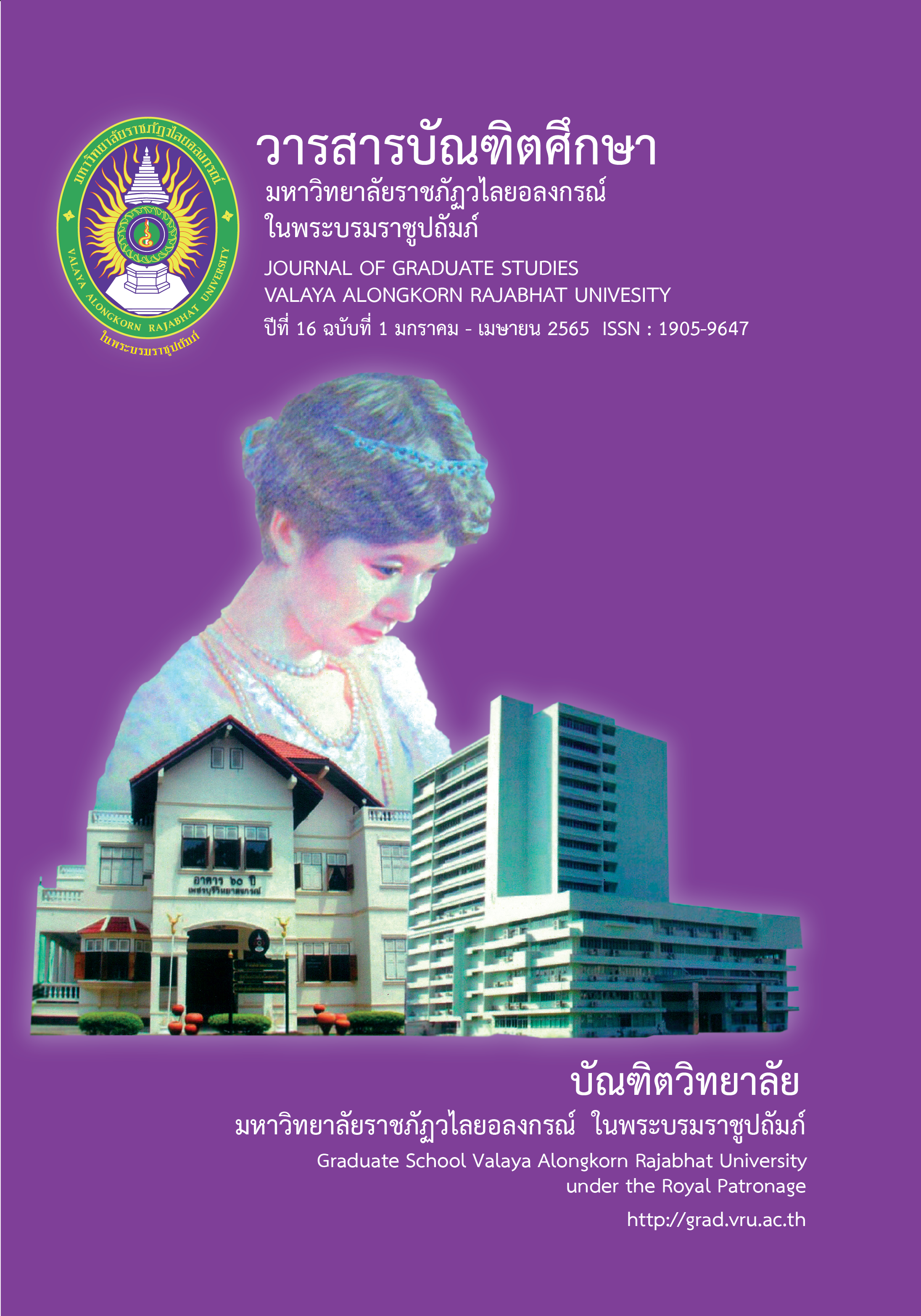BRAIN: BEHIND MORAL JUDGMENTS
Main Article Content
Abstract
In the present, education and psychology pay attention to the relationship of brain, thought, mind and behavior. This article presents about the mechanisms of human behavior in moral decisions, which is closely related to the structure and the functions of brain, by showing the evidence and findings to understand a person’s moral behavior in the view of neuroscientists as opposed to that of moral philosophers. It does not aim to judge what is right or wrong but to empathize with how people think, make decisions and have behavior, which is caused by the structure and the functions of neo cortical brain and limbic brain. The mechanisms of the brain affect humans’ moral behavior differently, which can help evaluate a person deeply and precisely. The data in this article can be guidelines for education and research applied to boost morality in many aspects.
Article Details

This work is licensed under a Creative Commons Attribution-NonCommercial-NoDerivatives 4.0 International License.
บทความทุกเรื่องได้รับการตรวจความถูกต้องทางวิชาการโดยผู้ทรงคุณวุฒิ ทรรศนะและข้อคิดเห็นในบทความ Journal of Global of Perspectives in Humanities and Social Sciences (J-GPHSS) มิใช่เป็นทรรศนะและความคิดของผู้จัดทำจึงมิใช่ความรับผิดชอบของบัณฑิตวิทยาลัย มหาวิทยาลัยราชภัฏวไลยอลงกรณ์ ในพระบรมราชูปถัมภ์ กองบรรณาธิการไม่สงวนสิทธิ์การคัดลอก แต่ให้อ้างอิงแหล่งที่มา
References
Amitai, S. & Joshua, D. G. (2014). Integrative Moral Judgment: Dissociating the Roles of the Amygdala and Ventromedial Prefrontal Cortex. The Journal of Neuroscience: The Official Journal of the Society for Neuroscience. 34(13), 4741-4749.
Brian, H., Bornstein, & Greene, E. (2011). Jury Decision-Making: Implications for and from Psychology. Current Directions in Psychology Science. 20(1), 63-67.
Brogaard, B. (2018). Do All Serial Killers Have a Genetic Predisposition to Kill?. Psychology Today. Retrieved from https://www.psychologytoday.com
Carlos, D. N., Melissa, M. M., Michael, L. M., & Benjamin, A. (2012). Virtual Morality: Emotion and Action in a Simulated Three-Dimensional "Trolley Problem". Emotion. 12(2), 364 –370.
Dolores, G. A. (2015). The Genetics of Violent Behavior. Retrieved from https://www.jax.or/news-and-insights/jax-blog/2015/december/the-genetics-of-violent-behavior
Dolan, E. W. (2017). In Depressed People, The Medial Prefrontal Cortex Exerts more Control over other parts of The Brain. Mental Health. Retrieved from https://www.psypost.org/2017/06/depressed-people-medial-prefrontal-cortex-exertscontrol-parts-brain-49168
Eslinger, P. J., et al. (2009). Development Frontal Lobe Imaging in Moral Judgment: Arthur Benton’s enduring influence 60 years later. Journal of Clinical and Experimental Neuropsychology. 31(2), 158-169.
Fiery, C., Rachel, S., Sophie, W., & Susan, C. (2013). The Development of Intent-based Moral Judgment. Cognition. 127(1), 6-21.
Goldstein, E. B. (2011). Cognitive Psychology: Connecting Mind, Research, and Everyday Experience: CogLab manual. 3rd ed. Wadsworth Cengage Learning.
Greene, J. D., Sommerville, R. B., Nystrom, L. E., Darley, & Cohen, J. D. (2001). An fMRI Investigation of Emotional Engagement in Moral Judgment. Science. 14(293), 2105-8.
Highsmith, J., Hernandez, J., & madrigal, S. (2015). Nature (MAOA) and Nurture in a Criminal. UC Merced Undergraduate Research Journal. 8(1), 1-11. Retrieved from https://escholarship.org/uc/item/5w51b7bg
Jitsattha, S. (2010). nǣokhit kīeokap khunnatham [Concept of Virtues]. (Available April 2, 2020). Retrieved from http://sumitta43.blogspot.com/2010/08/blog-post_14.html
Kendra, C. (2019). His Injury Led to New Discoveries in Neuroscience. (November 06, 2019). Retrieved from https://www.verywellmind.com/phineas-gage-2795244
Kohlberg, L. (1984). Essays on Moral Development: The Psychology of Moral Development. (2), San Francisco, Harper & Row. 684-709.
Kraivichien, T. (2007). khunnatham læ čhariyatham khō̜ng phūbō̜rihān [Morality and Ethics of Management]. Bangkok: Pimlak Press.
Lei, H., Di, H. & Rao, H. (2014). A Functional Polymorphism of the MAOA Gene Modulates Spontaneous Brain Activity in Pons. Journal of Biomedicine and Biotechnology. (2014), 1-8.
McFetridge, G. (2014). Cell Organelles and the Triune Brain. Retrieved from https://www.peakstates.com/triune.html
Molina, A. G. (2012). Phineas Gage and the Enigma of the Prefrontal Cortex. Neurologia. 20(6), 370-375.
Newman, T. (2017). All you need to know about neurons. MedicalNewsToday. Retrieved from https://www.medicalnewstoday.com/articles/320289
Northern Brain Injury Association. (2020). The Structure and Function of The Human Brain. Retrieved from https://www.nbia.xa/brain-structure-function
Office of the National Economic and Social Development Board. (2010). phǣn phatthanā sētthakit læ sangkhom hǣng chāt chabap thī sip (pī Phō̜.Sō̜. sō̜ngphanhārō̜ihāsip - sō̜ngphanhārō̜ihāsipsī) [The 10th National Economic and Social Development Plan and Creative Economy (2007-2011)]. Retrieved from http://www.ldd.go.th
Paul, D. M. (2007). Neuroscientist Who Devised ‘Triune Brain’ Theory. The New York Times. Retrieved from https://www.nytimes.com/2008/01/10/science/10maclean.html
Phanthumnawin, D. (2000). thritsadī tonmai čhariyatham : kānwičhai læ kānphatthanā bukkhalākō̜n [Ethical Tree Theory: Research and Human Resource Development]. 3rd ed. Bangkok: Chulalongkorn University.
Sangpithak, W. (2013). patčhai thī mī ʻitthiphon tō̜ khunnatham čhariyatham khō̜ng phūsamret kānsưksā laksūt phayābān sātbanthit [The factors influence to the moral ethics of the student who are finish graduate Bachelor of Nursing]. Journal of Boromarajonani College of Nursing, Bangkok. 29(2), 103-112.ra, E., et al. (2010). Utilitarian Moral Judgment Exclusively Coheres with Inference from is to ought. Frontiers in Psychology. 8(1042), 1-18.
Sophonpokai, K. (2010). "khunnatham" "čhariyatham" læ kān Damrong yū kap sangkhom prachāthipatai (khwāmmāi læ nǣokhit chœ̄ng thritsadī ) ["Morality" "Ethics"and on Living in a Democratic Society (Meaning and Theoretical Concepts)]. Office of the Inspector General. 3(2), 112-113.
William, H. (2012). Moral Evaluations of Harm are Instant and Emotional, Brain Study Shows. Retrieved from https://news.uchicago.edu/story/moral-evaluations-harm-are-Instant-and-emotional-brain-study-shows
Wongvanichtawee, C. & Narkwachara, S. (2018). nǣothāng kānčhatkān kān sœ̄msāng khunnatham læ čhariyatham dōi tang kham thām čhāk sathānakān sommotti [Managerial Guideline for Morality and Ethics Enhancement by Using Scenario Questions]. Academic Journal of Buriram Rajabhat University. 10(2), 1-20.
Zhuo, F., et al. (2017). Post-conventional Moral Reasoning is associated with increased Ventral Striatal Activity at Rest and During Task. Scientific Reports. 7(7105), 1-11.


